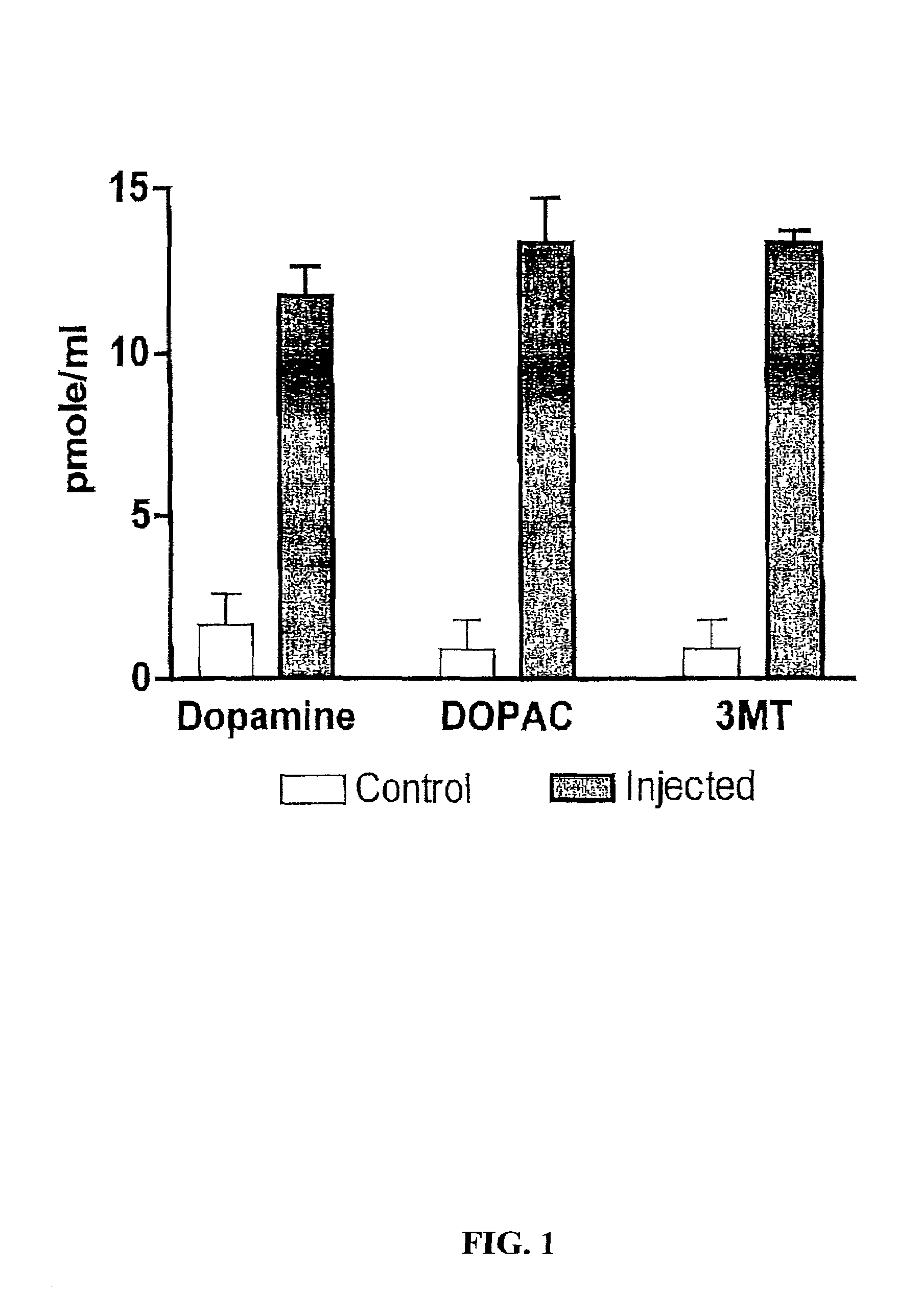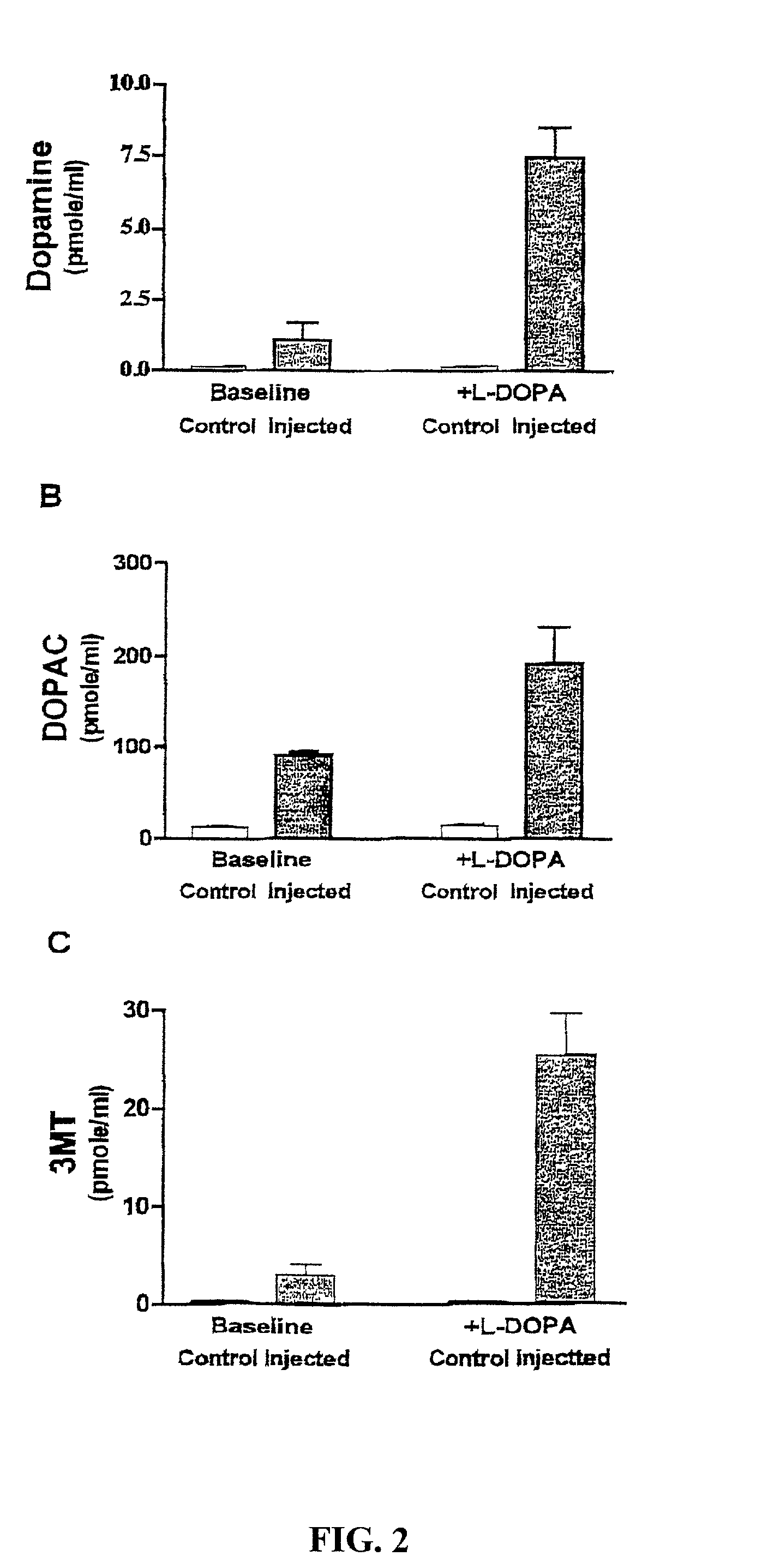Methods of treating Parkinson's disease using recombinant adeno-associated virus virions
a technology of adenovirus and parkinson's disease, applied in the direction of biocide, peptide/protein ingredients, genetic material ingredients, etc., can solve the problems of ineffective systemic administration, inability to administer many potentially useful compounds, such as proteins, and inability to form dopamine, so as to improve delivery and improve fine motor tasking , the effect of increasing the task of fine motor
- Summary
- Abstract
- Description
- Claims
- Application Information
AI Technical Summary
Benefits of technology
Problems solved by technology
Method used
Image
Examples
example 1
Recombinant AAV Tyrosine Hydroxylase Virion Preparation
[0035]Recombinant AAV virions containing the human tyrosine hydroxylase type 1 (TH) gene—the complete cDNA sequence for TH available under GenBank Accession No. X05290—were prepared using a triple-transfection procedure described in U.S. Pat. No. 6,001,650, supra.
Vector Construction
AAV pHLP19 Helper Function Vector Construction
[0036]The AAV pHLP19 helper function vector was constructed using standard molecular biological techniques; its construction is described in detail in U.S. Pat. No. 6,001,650, supra.
[0037]To summarize, the AAV pHLP19 helper function vector was constructed in a several-step process using AAV-2 sequences derived from the AAV-2 provirus, pSM620, GenBank Accession Numbers K01624 and K01625. First, the ITRs were removed from the rep and cap sequences. Plasmid pSM620 was digested with SmaI and PvuII, and the 4543 bp rep- and cap-encoding SmaI fragment was cloned into the SmaI site of pUC19 to produce the 7705-bp...
example 2
Recombinant AAV Aromatic Amino Acid Decarboxylase Virion Preparation
[0050]Recombinant AAV virions containing the human aromatic L-amino acid decarboxylase (AADC) gene—the complete cDNA sequence for AADC available under GenBank Accession No. M76180—were prepared using a triple-transfection procedure described in U.S. Pat. No. 6,001,650, supra. In summary the AAV pHLP19 helper function vector, the pLadeno1 accessory function vector, and the rAAV-AADC vector were used to produce rAAV-AADC virions.
[0051]The AAV pHLP19 helper function vector and the pLadeno1 accessory function vector were constructed as described in Example 1.
Recombinant AAV-AADC Vector Construction
[0052]The recombinant AAV-AADC vector was constructed exactly as in Example 1 for rAAV-TH vector production, with the exception that the AADC gene (GenBank Accession No. M76180) was used.
Recombinant AAV-AADC Virion Production
[0053]Recombinant AAV-AADC virion production was accomplished exactly as described in Example 1 for rAA...
example 3
Recombinant AAV Guanosine Triphosphate Cyclohydrolase I Virion Preparation
[0054]Recombinant AAV virions containing the human guanosine triphosphate cyclohydrolase I (GCH) gene—the complete cDNA sequence for GCH available under GenBank Accession No. NM—000161—were prepared using a triple-transfection procedure described in U.S. Pat. No. 6,001,650, supra. In summary, the AAV pHLP19 helper function vector and the pLadeno1 accessory function vector and the rAAV-GCH vector were used to produce rAAV-GCH virions.
[0055]The AAV pHLP19 helper function vector and the pLadeno1 accessory function vector were constructed as described in Example 1.
Recombinant AAV-GCH Vector Construction
[0056]The recombinant AAV-GCH vector was constructed exactly as in Example 1 for rAAV-TH vector production, with the exception that the GCH gene (GenBank Accession No. NM—000161) was used.
Recombinant AAV-GCH Virion Production
[0057]Recombinant AAV-GCH virion production was accomplished exactly as described in Example...
PUM
 Login to View More
Login to View More Abstract
Description
Claims
Application Information
 Login to View More
Login to View More - R&D
- Intellectual Property
- Life Sciences
- Materials
- Tech Scout
- Unparalleled Data Quality
- Higher Quality Content
- 60% Fewer Hallucinations
Browse by: Latest US Patents, China's latest patents, Technical Efficacy Thesaurus, Application Domain, Technology Topic, Popular Technical Reports.
© 2025 PatSnap. All rights reserved.Legal|Privacy policy|Modern Slavery Act Transparency Statement|Sitemap|About US| Contact US: help@patsnap.com


